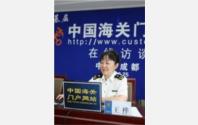 Online Interview
Online Interview
Topic: “QuanYuTong” Brings Steady Growth to Sichuan’s Foreign Trade
Time:10:00 AM (Wed) June 25, 2014
Special Guests:Ni Zao, Deputy Director General and Party Leadership Group Member of Chengdu Customs District
“QuanYuTong” Brings Steady Growth to Sichuan’s Foreign Trade
[Ni Zao]: You can take a look at the comparison chart for the two models. The parts marked yellow are the steps that have been removed in the new model:

[Wang Hua]: Looking at this, the original model involved dozens of steps between the enterprise and Customs. But with the new model there are only a dozen or so. It's obviously a lot simpler. 06/25/2014 10:15:00
[Ni Zao]: That's right. The "Multiple Declaration Points, Multiple Release Points" model removes the need to transfer within the Customs District. Enterprises can independently select a customs office to conduct inspection and release and independently organize transport. This removes 15 steps from the traditional model, greatly reducing time and cutting transport costs within the Customs District by 500-1,000 yuan per container. 06/25/2014 10:15:43
[Ni Zao]: Under the old model, if the goods were being shipped in by waterway after being imported from Shanghai, these transfer steps would have to be repeated every time something happened such as rivers drying up, or flooding, or having to change boat. This new model reduces the need for all these steps and saves more substantial costs. 06/25/2014 10:16:31
[Ni Zao]: For example, we looked at Zhongjia Automobile Manufacture (Chengdu) Co., Ltd. With the new "Multiple Declaration Points, Multiple Release Points" model, this company's customs clearance was shortened by 1 to 2 working days, and transport costs were reduced by around 2 yuan per kilogram. The company imported over 2,000 tons in the last 5 months, so they've saved around 4 million yuan on shipping alone. 06/25/2014 10:16:58
[Wang Hua]: At this point, some of our viewers might be feeling a little confused with this "Integration of Free Trade Zones and Ports" and "Multiple Declaration Points, Multiple Release Points", as well as the "Declaration at Hometown, Release at Port" you mentioned before. What's the difference between these? Can you explain them as simply as possible to us? 06/25/2014 10:17:49
[Ni Zao]: Basically, "Multiple Declaration Points, Multiple Release Points" and "Declaration at Hometown, Release at Port" involve the collection of import/export goods at port customs authorities, the declaration by enterprises to their local or self-designated customs authorities, and inspection and release of the goods at the ports. 06/25/2014 10:18:23
[Ni Zao]: The difference between the two is that "Declaration at Hometown, Release at Port" is a model used between customs districts, and there are certain requirements for an enterprise to be able to use this method: they must be enterprises with Customs management rating of AA, A, or manufacturing-based enterprises with the rating of B; while "Multiple Declaration Points, Multiple Release Points" is for within one customs district and applicable to enterprises with the rating of B or..above 06/25/2014 10:19:07
[Ni Zao]: The "Integration of Free Trade Zones and Ports" is used for transporting goods between customs supervision premises with intelligent checkpoints within one customs district. The goods will be transported via en-route monitoring to the Customs authority of declaration. 06/25/2014 10:19:50
Quick Links







